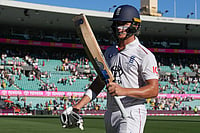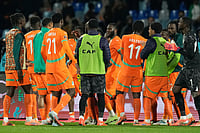INCREDIBLE but true. Marketmen insist sales of the Akai colour TV, emperor of exchange offers, despot of discounts, slid from 49,000 sets in May to 33,000 in June to 30,500 in July. In the meantime, BPL has moved sales up from 52,000 in May to 56,000 in June to 81,000 in July. Of course, BPL has also cut prices, but nowhere near Akai levels. If you turn in your old 21-inch CTV, you can get a BPL 29-incher for Rs 24,000. An Akai one comes for Rs 7,000 less.
What happened? Aren't big discounts enough? And if bigger discounts are not enough, what is?
These are the questions that are haunting every consumer goods marketer in the country.
For, the times don't seem to be getting any less tough. Last week, were you by any chance at South Extension, one of New Delhi's smartest shopping arcades? A year ago, it was nearly impossible to find a parking slot here at sunset hour, peak shopping time. The joke going round was that retailers here worry more about parking than profits. But today there are more ushers than chauffeurs waiting. The brightly-lit display windows, selling Italian, French and German brands, tell a grim story. Adidas: empty. Lacoste: empty. The Reebok Infiniti store has more mannequins than staffers, and more staffers than customers.
Across the road, a middle-aged couple wanders into electronics showroom Rhythm Corner. They want a new TV in exchange for their old one. The salesman painstakingly leads them through a wellrehearsed presentation of hot new features and technical nitty-gritty. Midway, he's cut short. What's coming free with the TV, asks the impatient buyer. Nothing at the moment, says the sheepish salesman. Couple moves towards the door.
So whatever the reasons for Akai's poor show in the last few months, discounts do seem to work. "When the chips are down, the psychology of the customer is to postpone buying of all non-essentials, typically lifestyle products, and he has to be lured into a buying decision with promotions, price cuts and incentive schemes," says Abhijit Sanyal, vice-president, Bausch & Lomb. His company is currently running a scheme where your old spectacle frame can be exchanged to get Rs 500 off on a Ray-Ban frame. This comes on the heels of a scheme where the purchase of one pair of Ray-Ban sunglasses fetched another for free. Bata has slashed prices by 50 per cent, Woodland by 40 per cent, Kidswear 70 per cent. Customers are coming in, albeit in a trickle.
Price war drums are beating in almost every industry, but nowhere as loud as in consumer electronics. Ever since Akai went on a rampage two years ago, the industry hasn't been the same. Today a BPL CTV sells at 30 to 35 per cent less than six months ago, Videocon at 15-20 per cent lower. Even LG Electronics, which has so far prided itself for taking the high technology ground, refusing to get into discount wars and exchange schemes, admits to having whittled prices down by 5 per cent.
There's hardly any appliance today that's not being sold at a new rate or without a freebie. Bring old gas stove along, get Rs 1,000 off on BPL gas table. Exchange old fridge, get Rs 6,000 off on new frost-free one. Buy National cooker, take home 15-piece bone-china tea set gratis. Last week, Kabir Mulchandani, boss of Baron International which markets Akai, announced a licensing agreement with Japanese brand Aiwa. He plans to do in the audio market with Aiwa what he did with Akai in TVs. Expect incredible deals, maybe somewhere they seem to be paying you to take their product home.
Even products and brands that normally don't lend themselves to price wars, either because they run a risk of image erosion or derive cache from premium pricing, are fin-ding it difficult to stay away from the discounting game. Daewoo was the first luxury car maker to slash prices. Now Maruti Zen has incurred an upgradation cost of Rs 40,000 on its new model but passed on only Rs 10,000 to the buyer. Ford's asking customers to exchange old cars for 1.6 Zetecs.
Price cuts, any marketing textbook would tell you, are good defence strategy. As long as they're temporary, targeted at specific customers or used to move excess inventory in a slowing market.
But what happens when discounting becomes a strategic weapon to grab market-share? "Competing on price will take you to a dead end. It's like drug addiction. First you do it for the thrill, then it becomes a necessity and then the necessity sucks you. You can say you're cheaper, but cheaper than whom and for how long?" asks Rajeev Kar-wal, vice-president, LG Electronics. The problem is that once someone slashes prices, it's very difficult for rivals not to follow suit. And in recessionary times, panic is easy to set in, so price-offs become a round-the-year phenomenon, a loop from which it's difficult to extricate your brand. Even when times turn better, Indian marketers will find it very hard to raise prices back to their normal levels. Paradoxically, that may not be so good for the customer in the long run. Because mad price-cutting has to finally impinge on product quality.
What's really happened to good old brand cache? Customer loyalty? Profits? Corporate planning? All seem to be on the casualty list. "It's sheer madness. Brands are being sold like vegetables," says marketing consultant Jagdeep Kapoor. "Many companies are still groping as the markets are in a churn. Earlier all MNCs focused on high-end goods at premium pricing for the middle class. Now they're focusing on only competitive pricing. The other elements of the marketing mix—customer satisfaction, brand communication, distribution efficiencies—are being given the go-by," says Arvind Singhal, managing director, KSA Technopak.
Fighting on price is easy. It brings quick volumes. But it can hurt business badly because it encourages buyers to focus only on a product's price tag, not its value or quality or benefits. Arvind Mills learnt this lesson the hard way. Three years ago, it launched the Ruf and Tuf brand of ready-to-stitch jeans at Rs 299 to draw consumers who aspired to don a pair of jeans but couldn't afford them. It worked: sales were a healthy 3.5 lakh units a month in 1996. In 1997, however, sales suddenly slumped to less than 1.5 lakh units a year. Arvind discovered that at that pricing, a lot of fly-by-night operators were able to make a killing while the 'original' company got bogged down with advertising and market development costs. Moral of the story: don't price to please the consumer, hoping the value proposition will hit. It only invites streetfighters to grab your market. Arvind has since axed ready-to-stitch Ruf and Tuf, introduced three price variants—Rs 299, Rs 379 and Rs 429—for the brand in the ready-to-wear format only.
"When the pie shrinks, the only strategy is: expand like mad into unexplored markets, domestic and overseas. Or plug the leaking margins by better inventory control, cost-cutting and distribution efficiencies. There is no third option available. Price-cutting can only be a tactical weapon," says Sundeep Malhotra, general manager, Bene-tton. His company has expanded its network by 55 per cent in the last 18 months. It has begun exporting to Australia and New Zealand and is looking to export back to Italy this year. On the price front, Benetton has actually upped rates on its basic polos and T-shirts, after maintaining prices for a good six seasons.
At the Levi-Strauss office in Bangalore, Vivek Raju, marketing manager, admits to using the price bait to woo his target customers—the 15 to 25-year-old: "Let's face it. Too many goodies—music CDs, shoes, fashion accessories—are chasing the same pocket allowance. Pricing jeans at Rs 995 breaks the Rs 1,000 psychological barrier that our product was initially factoring at Rs 1,150." This is not a price cut, he says: it doesn't dilute the brand, only makes it accessible. At the moment, Levi's marketing effort is concentrated on providing a better product range while making shopping fun. It's introduced a new concept of 'retainment' at its stores. Youngsters can now listen to the latest in music, exchange notes on the graffiti board and hang out while friends and family shop. "The idea is to keep the excitement alive around the brand. You have to constantly innovate. Pricing is just one element in the marketing mix," says Raju.
At LG, Karwal has silenced his critics who initially mocked at his high-horse views against exchange offers and discounts by clocking a Rs 200-crore sales turnover in the first year itself with its "honest-to-goodness" price strategy. He points to how the business landscape has been laid waste by price wars and exchange offers. "Around 50 per cent of colour TV sales today are from exchange offers. Had these not been offered, 10 per cent of the customers would have anyway come to the market because their old TVs wore out. Another 10 per cent with hand-me-downs in smaller markets would also have bought new sets. That accounts for 20 per cent of the 50 per cent. Overall then, the industry is losing 10 per cent growth," he reasons. LG, in fact, is pushing into the superpremium segment having just launched a 29" model—Golden Eye Swing—for Rs 69,000 and a 21" model for Rs 21,200.
So, how do the different players stack up as they redefine the rules of the game? Who will win? Difficult to say. The big boys—the likes of Levi's, Reebok, Benetton and Sony—will survive the carnage, by virtue of their deep pockets, if nothing else. But many will perish. That's the law of warfare.
Right now, however, the marketplace is good turf for no one—except the customer. He is singing a new tune. The lyrics: How Low Can You Go... How Much Can You Please.... Most companies have no choice but to waltz along.


























